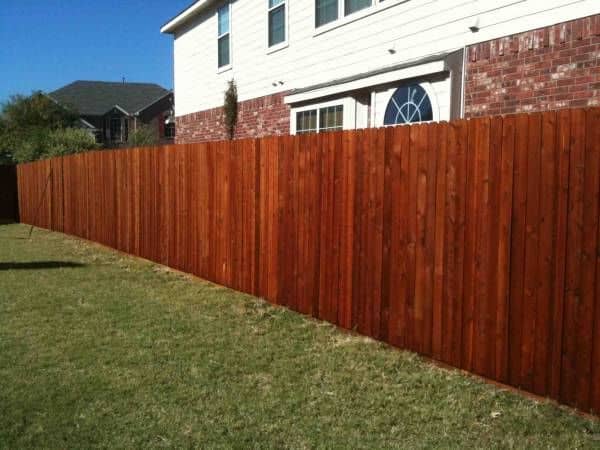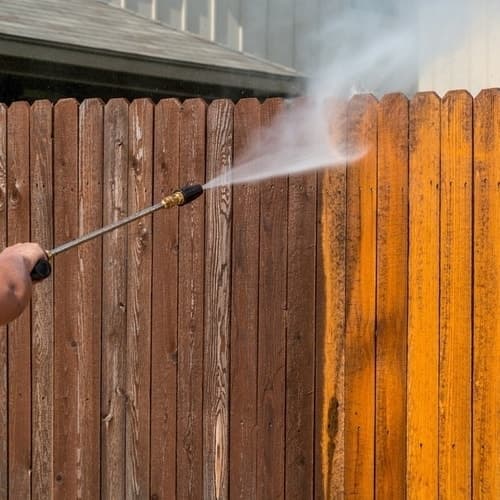The Ultimate Overview to Fence Staining: Tips and Techniques You Required to Know
In the realm of home maintenance, fence discoloration commonly arises as a task that needs focus but is regularly forgotten. The procedure involves more than just slapping on a layer of stain; it demands precision, expertise, and the appropriate techniques to ensure a resilient and visually appealing result. Whether you are a seasoned do it yourself fanatic or a homeowner wanting to improve the curb charm of your home, comprehending the subtleties of fence discoloration can make a considerable difference. Allow's discover the ins and outs of this seemingly simple yet surprisingly complex task to open the tricks that can change your fence from a mere boundary to a standout feature of your outdoor area.
Advantages of Fence Discoloration
What advantages does fencing staining deal to homeowners seeking to enhance both the appearance and durability of their outdoor structures? Fence discoloration gives various benefits that make it a preferred choice for homeowners looking to shield and enhance their fences.
Additionally, fence discoloration aids to secure the timber from the aspects, such as rain, snow, and UV rays. This security not just prevents the wood from rotting and decomposing however additionally extends its lifespan, conserving property owners cash on pricey fixings or substitutes over time. Fence Staining. Additionally, staining develops a barrier against insects, such as termites and carpenter ants, which can trigger significant damage to neglected timber fences
Selecting the Right Spot

An additional aspect to consider is the level of defense you want for your fencing. Transparent stains provide minimal security against UV rays and moisture, while semi-transparent and solid stains use increased protection. If your fence is revealed to severe weather conditions, a strong discolor might be the most effective alternative to make certain optimum resilience.

Preparing Your Fencing
Prior to applying the chosen discolor, extensive prep work of the fence surface is important to ensure optimum results. Begin by cleaning up the fencing to remove dirt, debris, and any old discolor or paint. Make needed repair work to ensure the fence is structurally sound.
After cleansing and repairing, it is vital to sand the fencing to create a smooth surface area for the tarnish to stick to. Utilize a medium-grit sandpaper to eliminate any kind of harsh patches or imperfections. Wipe down the fencing with a tack fabric to eliminate any kind of remaining dust bits.
Using the Discoloration

When applying the stain, work carefully section by section, starting from the leading and moving downwards to avoid drips and guarantee even insurance coverage. Use long, smooth strokes to use the stain in the instructions of the timber grain, permitting for much better infiltration and a more specialist coating.
Keeping Your Stained Fence
To guarantee the long life and visual charm of your tarnished fencing, regular maintenance is essential. The initial step in maintaining your stained fence is to routinely check it for any signs of wear, such as fading, peeling, or splitting. Resolving these problems promptly can prevent additional damage and expand the life of your tarnish. It is advised to cleanse your stained fence at the very least annually utilizing a moderate detergent and water to eliminate dust, gunk, and mold buildup. After cleaning, permit the fence to completely dry entirely before using any kind of extra treatments or stains. In addition, it is important to keep track of the sealant on your stained fence and reapply it as required to shield the timber from dampness and UV damage. Keep vegetation cut and away from the fence to prevent mold and mildew growth. By complying with these maintenance tips, you can make certain that your discolored fence stays in top problem for many years ahead.
Final Thought
To conclude, fence discoloration provides various advantages such as defense against weathering and boosting the visual allure of your residential property. By picking the best discolor, correctly preparing your fencing, using the stain properly, and maintaining it regularly, you can guarantee your fencing remains in leading condition for several years to come. Following these pointers and strategies will aid you attain a perfectly tarnished fencing that will certainly stand the examination of time.